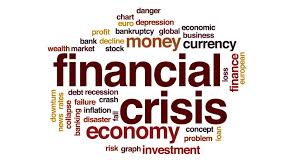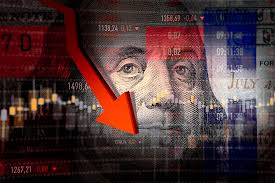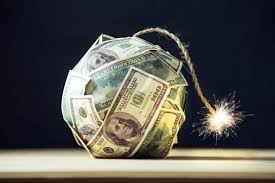JIM RICKARDS PREDICTS A HORRIBLE ECONOMIC CRISIS
collapse of the current financial system
Jim Rickards explains what is happening in the economy, and how he sees the monetary system going forward


Jim Rickards Predicts a Horrible Economic Crisis Where EVERYTHING WILL COLLAPSE
805K subscribers
37K views 8 days agoJim Rickards is predicting a collapse of the current financial system as the most likely scenario in his model.
JIM RICKARDS PREDICTS A HORRIBLE ECONOMIC CRISIS
BROUTHT TO YOU BY: CryptoGrizzTrader.com

VISIT OUR OTHER SITES:
Check Out Our Crypto Privacy Site: CryptoGrizz.com
Check Out Our Crypto Trading Site: CryptoGrizzTrader.com
Check Out Our Low Cap Altcoin Site: CryptoGrizzAltcoins.com
Check Out Our Prepper Site: PrepperGrizz.com
Check Out Our Prepper Survival Site: PrepperSurvival.org
Check Out Our Global Crypto Survival Site: GlobalCryptoSurvival.com
FULL VIDEO TRANSCRIPT
0:00less scenarios collapse which I actually0:02think is the most likely through a0:04combination of Wishful Thinking denial0:06delay we’ll probably just blunder into a0:08collapse at which point the response0:10would take the form of executive orders0:12and you know after social unrest0:13probably some kind of neo-fascism it’s a0:16good reason to believe that we are0:17looking at a potential collapse of0:20confidence in the US dollar and indeed0:22the entire international monetary system0:24the international monetary system is0:25based on the dollar so the dollar goes0:27the system goes that’s not meant to be a0:29provocative statement the international0:30monetary system is actually collapsed0:32three times in the past hundred years in0:351914 1939 and 1971. so this would be the0:39fourth collapse in 100 years and not0:41that infrequent and when the monetary0:43system collapses it’s not the end of the0:45world we don’t all go live in caves who0:47do canned goods and all that what0:49happens is the major trading and0:50financial Powers get together they sit0:52down and they re-cut the deal what’s0:54called the rules of the game so what I0:56want to think about a little bit is0:57since we can see the collapse coming is0:59what are the new new rules of the game1:00what would the international monetary1:02system of the future look like as a1:04result of a sort of a new brettonwood1:05style conference uh in the face of a1:07collapse I’ve got four scenarios here1:09mobile Reserve currencies sdrs gold and1:13collapse followed by something worse1:14multiple Reserve currencies the ideas1:16you know in two thousand seventy percent1:19of international reserves were held in1:20dollars today that number is 60 it’s1:23trending down so imagine a world where1:25the dollar goes below 50 maybe it’s 451:28or 40 percent the Euro comes up you know1:31the Australian dollar in Canadian dollar1:32were just recently admitted by the IMF1:34as official Reserve currency so they1:36have a larger role and we end up in the1:38situation where you get a whole bunch of1:40Reserve currencies I call it the Kumbaya1:42solution we all just get along this1:44won’t work this is unstable because1:45there is no anchor there’s no gold1:47there’s no dollars so instead of one1:49Central Bank Behaving Badly you’d have1:51five or six or seven behaving badly I1:53think this would exacerbate rather than1:54mitigate the currency Wars the next one1:57this is the one preferred by the elites1:58when I say Elites sound of deep dark2:01conspiracy you know Finance ministers2:02treasury secretaries academics Central2:04Bankers other policy makers this is the2:07SDR the SDR is a special drawing line2:09it’s understood by very few people but2:11it’s unbelievably simple the way to2:13understand it the FED has a printing2:14press they can print dollars the2:16European Central Bank has a printing2:18press they can print euros and the IMF2:20is a printing press they can print sdrs2:22and that’s all it is it’s World money2:24they can print as much as they want they2:25hand it out they can reflate and2:27re-liquify the global economy the IMF2:30actually has a 10-year plan to make the2:32SDR the global Reserve currency again2:34not a secret you can find it on their2:35website I want to give a quick example2:37because I know this is attuned to a2:39policy but how the SDR is already sort2:41of creeping into our system the United2:43States Treasury got authority to provide2:47a hundred billion dollars to the IMF2:49this was legislation passed in 2009. so2:52what did the IMF do with the money well2:54what they did is they if you look at the2:56total IMF loans credit lines Etc 912:59percent of all the IMF loans in advances3:02they want to bail out Europe or to3:04Mexico only nine percent went to the3:06rest of the world I leave it to you to3:08decide whether the president was3:09entirely candid with the Congress when3:11he said this is primarily for developing3:13an emerging market economies you don’t3:15see Korea Indonesia India Brazil3:17Thailand Malaysia you don’t see those3:19countries getting more than nine percent3:21of the IMF money this money basically3:23went to bailout Europe that’s another3:24thing where again I think the American3:26people were a little more aware they3:27might raise a few questions3:29um third outcome is the gold standard3:31I’m just going to go through this very3:32quickly all gold standards are relation3:34between paper money and gold but you3:37have to ask yourself a couple questions3:39when you set up a gold standard first3:41one is what’s your definition of money3:42because we have m0 M1 M2 these are3:45technical definitions they’re all3:47different so you have to pick one of3:49those to be your money the second one is3:51what’s the proper Reserve ratio do you3:53need a hundred cents on the dollar of3:55gold to back all the paper money well a3:57lot of gold bugs would say yes but3:59historically that’s not true England ran4:00a very successful gold standard in the4:0219th century with 20 percent back in the4:04United States through most of the 20th4:06century was on the gold standard with 404:08backing so history says you can have 204:10or 40 backing uh and and that works just4:13fine third thing is which nations are4:15included the simplest way to understand4:17that the U.S could do this on its own4:19but it would be a blunder because if we4:21had a gold standard a dollar back by4:24gold and we were the only one doing it4:26all the other currencies in the world4:27would essentially be worthless nobody4:29would want anything other than dollars4:31which would be extremely deflationary4:33because the other currencies would not4:34be desirable and it would repeat the4:36blunder Winston Churchill made 1925. so4:38we’ll look at what with those criteria4:40look at actually where the gold is if4:42you take the 17 members of the European4:44monetary system those who backed the4:46Euro They have ten thousand tons the4:48United States says 8 000 tons the IMF is4:51about 3 000 tons you see China4:52Switzerland it kind of tails off after4:54that so the good news for the US and4:56Europe is we still have all the gold and4:58I think we will have the largest voice4:59by far if there is a new international5:02monetary conference with one footnote5:03which is China is non-transparent so5:06that China bar that one thousand tons is5:08probably closer to 4 000 tons we’ll5:10probably learn that a year from now when5:12they update their figures so China has5:14bought themselves a very big seat at the5:16table so the first one the global money5:18Global M1 40 backing that’s about seven5:21thousand dollars an ounce now is that’s5:23what the price of gold would have to be5:25to support the money supply without5:27deflation so it’s the non-deflationary5:29applied price to Gold Global money5:31supply Global M2 with 100 backing is5:34forty four thousand dollars an ounce the5:35last scenario is collapse which I5:37actually think is the most likely5:38through a combination of Wishful5:40Thinking denial delay misapprehension of5:43those statistical properties of risk and5:44bad policy will probably just blunder5:46into a collapse at which point the5:48response would take the form of5:49executive orders and you know after5:51social unrest probably some kind of5:53neo-fascism the way to understand it we5:55have inflation and deflation going on at5:58the same time two opposite ideas6:00happening at the same time the deflation6:02is natural it’s what happens in a6:04depression because of deleveraging so6:06what’s deleveraging well I have to sell6:08assets to pay off debt when I sell6:10assets it tends to depress the price I6:13pay off the debt but prices are going6:14down so now you have to sell more assets6:16to pay off more debt Etc and you get6:18into a debt deflation cycle until you’ve6:21liquidated everything and prices hit6:23bottom and the kind of people started6:25looking around for bargains again the6:27cycle starts to term but it can go a6:28very long way and Irene Fisher wrote6:30about this in the 1920s in the debt6:32deflation cycle a theory of the Great6:34Depression but opposing that we have6:36inflation coming from policy what’s6:38actually going on is we have sort of a6:40notional five percent deflation and a6:43notional five percent inflation the6:45deflation from deleveraging the6:47inflation from policy and they’re6:49pushing against each other and they’re6:51canceling each other out but it’s not6:53stable you’ve got these two forces and6:55one of them is going to Prevail it’s6:56going to snap and it could snap out of6:58the way it could go into much more rapid6:59at inflation or much more serious7:01deflation got the monetary policy roots7:04of this here’s uh the basic statement of7:06the quantity Theory money now you all7:08learned this in your first week of7:10macroeconomics but it’s the equation is7:12MV equals PQ m is your money supply V is7:16the velocity velocity is just the7:18turnover of money so you know I go to7:21the bar tonight and I leave a tip and7:22the bartender takes the tip and takes7:24the taxi home and the taxi driver takes7:26the fair and puts gasoline in his car7:28that dollar has velocity of three7:30because one dollar supported three7:32dollars of goods and services the tip7:34the taxi and the gasoline but if I stay7:36home and don’t spend any money my money7:38has velocity of zero so and I remind7:41people three trillion dollars times zero7:43is zero in other words if you don’t have7:45velocity you don’t have an economy so7:48basically money supply how much money is7:50there times velocity how quickly is it7:52turning over equals the nominal GDP the7:55gross dollar value of all the goods and7:57services in the economy and nominal GDP7:59he has two parts a q is the real part8:02and P is the price index so inflation or8:04deflation but this is psychological they8:07have to basically lie to you they have8:09to engage in propaganda to bend the8:11velocity curve to make you want to spend8:13more money than you’re actually doing8:14right now so that they can get8:15phenomenal growth they need to pay off8:17the debt so how do you bend the velocity8:19curve what is the policy here and as I8:21mentioned is exercise and propaganda two8:24ways to do it two tools like this the8:26first is negative real rates negative8:28real rates is when inflation is higher8:30than the nominal rate that’s good8:32because if you’re a borrower in that8:34world you actually pay the bank back in8:36cheaper dollars that’s better than zero8:38interest that’s the bank paying you to8:39be a borrower so ideally the FED would8:42say we’ll have two percent on the8:4310-year note and three percent inflation8:45negative real rates of one percent8:47that’s a very powerful investment to go8:49out and borrow the other thing they want8:51to do is deliver an inflationary shot if8:53I promise you two percent and I deliver8:55two percent there’s no change in8:57Behavior I’ve exactly met your8:59expectations Nation so there’s no reason9:00for you to change your behavior what I9:02have to do is lie to you I have to tell9:04you two percent and deliver three9:05percent that’s a shock now you’re like9:07oh gee inflation’s out of control better9:08go buy a house buy a car buy a9:10refrigerator do whatever so that changes9:12Behavior so three percent inflation with9:15two percent or two and a half percent on9:16the 10-year note is a negative interest9:18rate which is a powerful inducement to9:20borrow and it’s also inflation shock9:23which is a powerful inducement to spend9:24and the idea of three percent inflation9:26is to get the borrowing and the lending9:28and spending machine going again try to9:30get nominal GDP back to Trend make it9:32self-sustaining withdrawal policy9:34substitute real GDP for nominal GDP get9:37real GDP back to trade and we all live9:38happily ever after this is what the FED9:40is trying to do they’re going to fail9:42but it’s important understand what9:44they’re trying to do why they’re trying9:45to do it then when you see them failing9:47it’s very easy to forecast monetary9:49policy because they’re just going to do9:51more of it until they get what they want9:52why do they have to get this well why do9:55they have to have inflation uh what’s9:57wrong with a little deflation well9:59here’s what’s control that this is10:00actually the fed’s worst nightmare the10:02government in economic theory inflation10:04and deflation you know prices are going10:06up prices are going down so what you10:08know you get a raise or you don’t get a10:10raise or you get a little benefit or10:11they’re winners and losers it would seem10:13like a normal economic process but the10:15government’s view of inflation deflation10:17is asymmetric they have to have10:19inflation they cannot have deflation10:21they can’t tax it so imagine you make a10:25hundred thousand dollars a year and your10:27boss gives you ten thousand dollar raise10:28and prices are constant okay so you just10:31had a ten thousand dollar increase in10:33your real standard of living you got ten10:34thousand more prices are the same except10:36what happened so the government comes10:38along and takes half they take five10:39thousand and you get the other five10:41thousand but imagine an opposite case10:42you’re making a hundred thousand a year10:44you don’t get a raise but prices drop10:46ten percent well you have the same ten10:49thousand dollar increase in your10:51standard of living your salary didn’t go10:52up at all but the price of everything10:53you buy went down so you’re better off10:56except that now you get to keep the10:58whole ten thousand dollars because as10:59the government doesn’t know how to tax11:01deflation so deflation can increase the11:04real standard of living of the American11:06people but the government won’t allow it11:08because they can’t tax it it destroys11:10tax revenuesEnglish (auto-generated) 18:38NOW PLAYING


